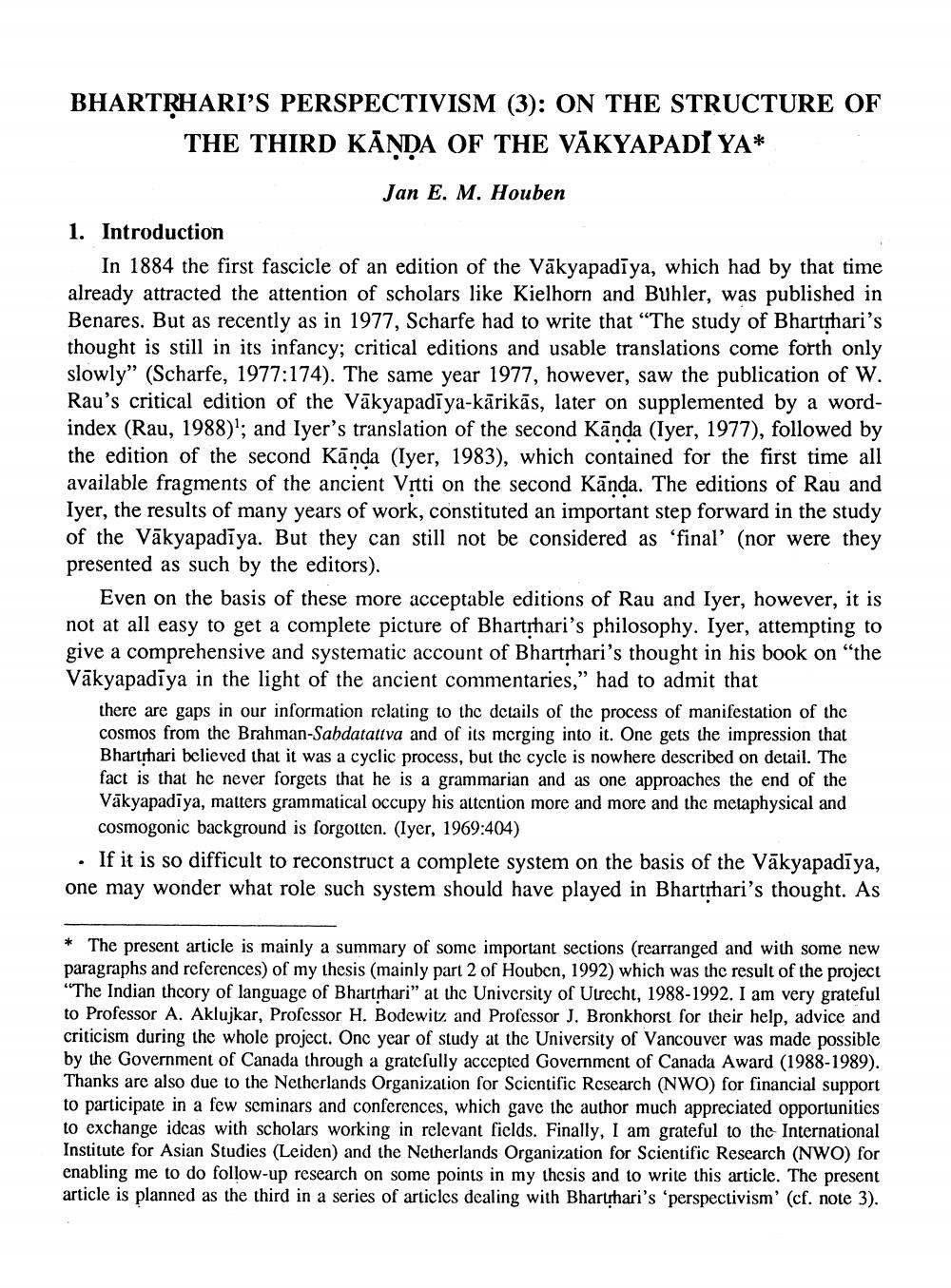________________
BHARTRHARI’S PERSPECTIVISM (3): ON THE STRUCTURE OF
THE THIRD KĀNDA OF THE VĀKYAPADI YA*
Jan E. M. Houben
1. Introduction
In 1884 the first fascicle of an edition of the Vākyapadīya, which had by that time already attracted the attention of scholars like Kielhorn and Buhler, was published in Benares. But as recently as in 1977, Scharfe had to write that “The study of Bhartīhari's thought is still in its infancy; critical editions and usable translations come forth only slowly" (Scharfe, 1977:174). The same year 1977, however, saw the publication of W. Rau's critical edition of the Vākyapadiya-kārikās, later on supplemented by a wordindex (Rau, 1988)'; and Iyer's translation of the second Kānda (Iyer, 1977), followed by the edition of the second Kānda (Iyer, 1983), which contained for the first time all available fragments of the ancient Vrtti on the second Kānda. The editions of Rau and Iyer, the results of many years of work, constituted an important step forward in the study of the Vakyapadiya. But they can still not be considered as `final (nor were they presented as such by the editors).
Even on the basis of these more acceptable editions of Rau and Iyer, however, it is not at all easy to get a complete picture of Bharthari's philosophy. Iyer, attempting to give a comprehensive and systematic account of Bhartrhari's thought in his book on the Vākyapadīya in the light of the ancient commentaries," had to admit that
there are gaps in our information relating to the details of the process of manifestation of the cosmos from the Brahman-Sabdatativa and of its merging into it. One gets the impression that Bharthari believed that it was a cyclic process, but the cycle is nowhere described on detail. The fact is that he never forgets that he is a grammarian and as one approaches the end of the Vākyapadiya, matters grammatical occupy his attention more and more and the metaphysical and
cosmogonic background is forgotten. (Iyer, 1969:404) • If it is so difficult to reconstruct a complete system on the basis of the Vākyapadīya, one may wonder what role such system should have played in Bharthari's thought. As
* The present article is mainly a summary of some important sections (rearranged and with some new paragraphs and references) of my thesis (mainly part 2 of Houben, 1992) which was the result of the project “The Indian thcory of language of Bharthari" at the University of Utrecht, 1988-1992. I am very grateful to Professor A. Aklujkar, Professor H. Bodewitz and Professor J. Bronkhorst for their help, advice and criticism during the whole project. Onc year of study at the University of Vancouver was made possible by the Government of Canada through a gratefully accepted Government of Canada Award (1988-1989). Thanks are also due to the Netherlands Organization for Scientific Research (NWO) for financial support to participate in a few seminars and conferences, which gave the author much appreciated opportunities to exchange ideas with scholars working in relevant fields. Finally, I am grateful to the International Institute for Asian Studies (Leiden) and the Netherlands Organization for Scientific Research (NWO) for enabling me to do follow-up research on some points in my thesis and to write this article. The present article is planned as the third in a series of articles dealing with Bharthari's 'perspectivism' (cf. note 3).




